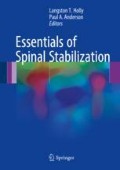Abstract
Since the shift from open surgery to minimal access surgery on the lumbar spine, the minimally invasive lumbar interbody fusion technique has quickly evolved and has gained a prominent position as the leading minimally invasive surgical intervention for decompression and stabilization of the lower segments of the lumbar spine. Spondylolisthesis, advanced degenerative disc disease, and severe foraminal compromise from coronal imbalance are the various degenerative conditions readily amenable to being addressed with minimally invasive techniques. This chapter details the evolution of the technique, establishes a rationale for what has been termed the “mini-open” technique, and details the operative technique and operative nuances of minimally invasive transforaminal lumbar interbody fusion.
Access this chapter
Tax calculation will be finalised at checkout
Purchases are for personal use only
Abbreviations
- ALIF:
-
Anterior lumbar interbody fusion
- AP:
-
Anteroposterior
- MIS:
-
Minimally invasive surgery
- MR:
-
Magnetic resonance
- TLIF:
-
Transforaminal lumbar interbody fusion
- VAS:
-
Visual analog scale
References
Foley KT, Smith MM. Microendoscopic discectomy. Tech. Neurosurg. 1997;3(4): 301–7
Cloward RB. The degenerated lumbar disc: treatment by vertebral body fusion. J Int Coll Surg. 1954;22(4 Sect. 1):375–86. Epub 1954/10/01
Harms J, Jeszenszky D. The unilateral, transforaminal approach for posterior lumbar interbody fusion. Orhtopaedics and Traumatology. 1998;6(2):88–99.
Foley KT, Holly LT, Schwender JD. Minimally invasive lumbar fusion. Spine. 2003;28(15 Suppl):S26–35. Epub 2003/08/05
Isaacs RE, Podichetty VK, Santiago P, Sandhu FA, Spears J, Kelly K, et al. Minimally invasive microendoscopy-assisted transforaminal lumbar interbody fusion with instrumentation. J Neurosurg Spine. 2005;3(2):98–105. Epub 2005/12/24
Holly LT, Schwender JD, Rouben DP, Foley KT. Minimally invasive transforaminal lumbar interbody fusion: indications, technique, and complications. Neurosurg Focus. 2006;20(3):E6. Epub 2006/04/08
O’Toole JE, Eichholz KM, Fessler RG. Surgical site infection rates after minimally invasive spinal surgery. J Neurosurg Spine. 2009;11(4):471–6. Epub 2009/11/26
Rampersaud YR, Foley KT, Shen AC, Williams S, Solomito M. Radiation exposure to the spine surgeon during fluoroscopically assisted pedicle screw insertion. Spine. 2000;25(20):2637–45. Epub 2000/10/18
Hsieh PC, Koski TR, O’Shaughnessy BA, Sugrue P, Salehi S, Ondra S, et al. Anterior lumbar interbody fusion in comparison with transforaminal lumbar interbody fusion: implications for the restoration of foraminal height, local disc angle, lumbar lordosis, and sagittal balance. J Neurosurg Spine. 2007;7(4):379–86. Epub 2007/10/16
Mummaneni PV, Rodts GE Jr. The mini-open transforaminal lumbar interbody fusion. Neurosurgery. 2005;57(4 Suppl):256–61. discussion -61. Epub 2005/10/20
Wong AP, Smith ZA, Nixon AT, Lawton CD, Dahdaleh NS, Wong RH, et al. Intraoperative and perioperative complications in minimally invasive transforaminal lumbar interbody fusion: a review of 513 patients. J Neurosurg Spine. 2015;22(5):487–95. Epub 2015/02/24
Raynor BL, Lenke LG, Bridwell KH, Taylor BA, Padberg AM. Correlation between low triggered electromyographic thresholds and lumbar pedicle screw malposition: analysis of 4857 screws. Spine. 2007;32(24):2673–8. Epub 2007/11/17
Hoshide R, Feldman E, Taylor W. Cadaveric analysis of the Kambin’s triangle. Cureus. 2016;8(2):e475. Epub 2016/03/24
Bakhsheshian J, Khanna R, Choy W, Lawton CD, Nixon AT, Wong AP, et al. Incidence of graft extrusion following minimally invasive transforaminal lumbar interbody fusion. J Clin Neurosci. 2016;24:88–93. Epub 2015/11/19
Author information
Authors and Affiliations
Corresponding author
Editor information
Editors and Affiliations
Rights and permissions
Copyright information
© 2017 Springer International Publishing AG
About this chapter
Cite this chapter
Tumialán, L.M. (2017). Minimally Invasive Posterior Lumbar Fusion Techniques. In: Holly, L., Anderson, P. (eds) Essentials of Spinal Stabilization . Springer, Cham. https://doi.org/10.1007/978-3-319-59713-3_28
Download citation
DOI: https://doi.org/10.1007/978-3-319-59713-3_28
Published:
Publisher Name: Springer, Cham
Print ISBN: 978-3-319-59712-6
Online ISBN: 978-3-319-59713-3
eBook Packages: MedicineMedicine (R0)

